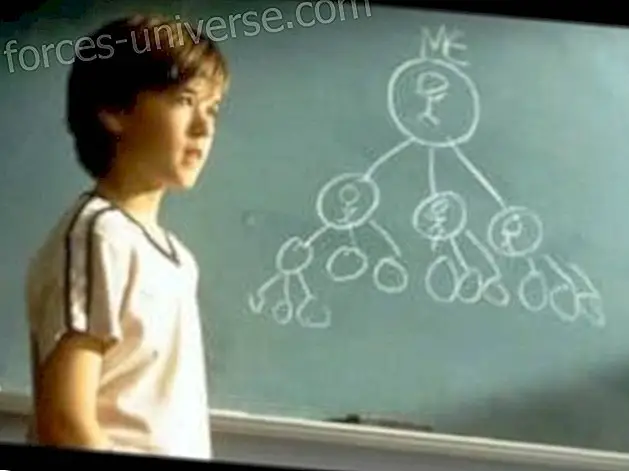INNOVATION COURSE Unit 1: The sciences. Learning Object 1: Cognitive Science
This course is aimed at technicians, technologists and engineers interested in understanding the transition from invention to innovation, to contribute to the development of humanity.
With the term research and development, reference is made to research in applied sciences or basic science used for engineering development, which pursues with the union of both areas an increase in innovation that leads to an increase in business sales.
The method of invention, as Edgar Poe demonstrated in his Philosophy of Composition, is simply to begin with the solution of the problem or with the desired effect. Then it goes back, step by step, to the point where you must start to get the solution or the effect. Such is the method in the detective novel, in the symbolic poem and in contemporary science. The great discovery of the nineteenth century was the discovery of the method of discovery, as AN Whitehead put it.
“The greatest invention of the nineteenth century was the invention of the method of inventing. A new method saw the light. To understand our time we can neglect all the details of the change, such as the railroad, the telegraph, the radio, the mechanical loom, the synthetic dyes. We have to focus on the method itself; This is the real novelty that has demolished the foundations of the old civilization ... One of the elements of the new method is precisely the discovery of how to apply to fill the gap between scientific ideas and the ultimate product. It is a process of disciplined attack against one difficulty after another. ”
SCIENCE AND THE MODERN WORLD
OBJECTIVES
- Establish relationships between research, development and innovation.
- Establish differences between systems and models.
- Understand learning from the model of cognitive science.
RULE ONE
May the group remain within the fire of the mind, focused on the clear light of the head. Behind the group is the Portal. Before him the Way opens. May the group of brothers move forward together .
INTRODUCTORY ACTIVITY: Illustrated and addicted

Rannulph Junuh is a golf player who is sent to fight in World War I. He returns with sequels and is consumed inside. An exhibition golf tournament is held to advertise the golf course and Savannah, the town where Junuh comes from. The two best players participate in the tournament and Junuh is invited to take part to represent the people. Before starting the tournament, a peculiar caddy appears, a black man who will help Junuh find the game he lost when he went to war, comparing with subtle systemic perception metaphors, life itself with the sport he loves, golf. The Legend of Bagger Vance is a 2000 American film, directed by Robert Redford, based on the homonymous novel by Steven Pressfield. The story takes place in the state of Georgia in 1931.
Eddie Morra is an aspiring writer who suffers a chronic block at the time of writing his books and, in addition, has recently ended a romantic relationship with his girlfriend Lindy. His life takes an unexpected turn when his excuded Vernon Gant unveils the NZT, a revolutionary medicine that will allow him to exploit his full cognitive potential. With each and every nerve impulse in his brain, Eddie can remember absolutely everything he has seen, read or heard; You can even learn languages fluently just by listening to them, as long as you continue taking the experimental drug. Eddie will soon get his first rewards thanks to the NZT, such as his conquest of Wall Street. His exploits make an important tycoon to notice him, Carl Van Loon, who invites him to be part of the most important corporate merger in history. However, not everything will be good news, as there is a group of people desperate to get a dose of NZT. Eddie will be involved in a dangerous police plot, run away from those who persecute him and try to hold on to his ever-smaller supply of the medication. Unlimited is a 2011 science fiction movie.
- After watching the films The Legend of Bagger Vance and Unlimited, answer the following questions. What is lighting? How are lighting and golf related? What is systemic perception? What is the relationship between information and addiction? What is the importance of play and literature for learning?
The issue to be addressed throughout the course will be Innovation, and the key motivation for everything that may appear in the readings under study is to become an expert learner. To achieve this, we will take the fourteen rules for group learning, I will comment on them by applying them to the disciple's work, giving practical suggestions to better develop the contact and manifestation of the soul. This is an NN course for AA : Nothing New for Accepted Apprentices.
ACTIVITY ONE: research

Science is a process of inquiry that includes procedures for answering questions, solving problems and developing more effective procedures for answering questions and solving problems. But not all inquiries are scientific. It is generally recognized that through the use of science, the chances of obtaining the correct answers to the questions and the best solutions to the problems are greater. In science, the purpose of any investigation is not limited to answering a question or solving a problem, but it also aims to test, evaluate and improve the research procedures used. Scientists tend to restrict the use of the term experimentation to inquiry that includes physical manipulation and to use the term research to refer to experimentation and any other type of controlled inquiry.
In the days when all scientists were philosophers and most philosophers were scientists, great attention was paid to the way knowledge was acquired. The investigation of this procedure was called interchangeably epistemology and theory of knowledge. With the separation of science from philosophy came a greater awareness of the superiority of the methods and techniques used by science to acquire knowledge. The scientific method raises the way in which techniques in science are selected, that is, the evaluation of alternative scientific courses of action. The methods are rules of action, the techniques are the choices themselves. In general, in applied science you have the opportunity to make decisions about research design with more knowledge bases than in pure science.
For a long time there has been a confusion between the epistemological (the nature of knowledge) and the psychological (the processes that lead to knowledge), which is what in practice leads us to learning. Learning in turn implies discipline which is also understood from two points of view: as a field of science or as behavior of the human being who wants to learn.
Half a century ago a new movement in science began to form, under the name of cognitive science, which attempts to integrate various disciplines in order to offer a better and more complete picture of the human mind. Behaviorists and cognitivists advocated from each pole a particular model of mind: the former approached it from the organism and the latter from a mechanism. Some specialists speak of modules of the mind and others of a society of the mind. This course will talk about intelligences, understood as the ways in which a person acquires information, retains and manipulates that information, and shows other people and themselves what they understand.
- Establish relationships and differences between cognitive, intellectual and knowledge.
ACTIVITY TWO: the development

Technology implies the ability to change the world or accommodate it. The difference between science and technology is found in the perspectives of applying knowledge to the solution of practical problems, hence the technology comes from applied science. The interdependence relationship between science and technology is getting closer. Engineering is a good example of this. Understood as the construction of problems and the design of solutions for them, it can be seen as a bridge of exchange between science and technology.
It was in engineering that systemic thinking emerged as a fifth discipline, one that integrates another four in systems analysis and includes the ability to use mental models. Systemic thinking was an alternative proposal to operations research that began its descent. Operations Research came to be identified with the use of mathematical models and algorithms instead of being identified with the ability to formulate management problems, solve them, and implement and maintain solutions in a turbulent environment.
Learning began to be understood as the way to appropriate knowledge. Pedagogy resurfaces as a science of action. A cybernetic attitude in pedagogy is to analyze the input flows (questions asked by the teacher) and the output flows (answers given by the apprentice). The beginnings of cyber pedagogy can be located in 1954 when Skinner published his experiences on domestication of animals. But while cybernetics was dedicated to the study of organisms, the administration was dedicated to the study of organizations.
During twenty-five years (1945-1970) extraordinary advances were made in our knowledge of what the environment is, what an organism is and, eventually, what the mind is. These advances come from cybernetics, systems theory, information theory and related sciences. Gregory Bateson postulated that an entirely new epistemology would have to emerge from cybernetics and systems theory, which would imply a new understanding of the mind, person, human relations and power, as well. He argued that the theology of Alcoholics Anonymous coincided closely with an epistemology of cybernetics. In 1956 the expression artificial intelligence that included previously disparate fields such as operational research, cybernetics, logic and computer science was coined. Cognitive science, meanwhile, tries to integrate knowledge of disciplines such as psychology, linguistics, artificial intelligence and neuroscience in order to offer a better and more complete picture of the human mind . We will consider a mental fusion technique that will bring enlightenment, imagination and inspiration; by correlating the three entrance doors to the mind.
- Establish relationships between innovation, enlightenment, imagination and inspiration.
ACTIVITY THREE: systems and models

Creative art is the highest instrument of cognition. Using time and space we learn to conquer the One who is outside of time and space. If cinema is the seventh art, it is because there are six others that precede it.
Guilford (1967) speaks of thinking styles and distinguishes two types of cognitive skills: divergent and convergent. In his model of the structure of the intellect he states that divergent production is the operation that is most clearly related to creativity and divides it into fluidity or ability to generate ideas, flexibility or ability to select problem solutions, among many categories and possibilities, originality, related to the generation of unique and new solutions to the problems that arise and elaboration, linked to the ability to perceive deficiencies, generate ideas and refine them to get new improved versions.
Perkins (1983) considers that the ability and willingness to design is a characteristic present, to a greater or lesser extent, in a large part of the population and suggests a model for understanding the creative and inventive process based on design. It associates the teaching of creativity with inventive thinking and uses design as a bridge concept and as an instrument to achieve its objectives.
Design and invention have emerged as the main modalities of the systems age. Prediction and preparation involve passive adaptation to a medium that is considered beyond our control. The design and the invention involve the active control of the medium of a system as well as of the system itself. A model is the representation that is made of a system.
A model is a master design from which copies are made. The original model can be projected as material, mental or spiritual or any combination of these energies. The reality of every model consists of its energies, its components. Personality and mind-spirit relationships are transmissible, but the original model is not. The models are never reflections; They are duplications, reproductions. The model reveals the individual aspect of energy and personality.
The terms experience, expertise and expertise are valid alternatives in Spanish to foreign expertise, which means in English 'skill or special knowledge' or 'skill or knowledge of an expert'. In Latin America it is common to hear the expression indigenous malice, which is not related to evil but to insight.
- Establish relationships between the mental model and the human design model.
THE MIND AS A LEARNING SYSTEM

The mind consists of three subsystems: an electrochemical subsystem, an electromagnetic subsystem and a self-conscious device. Human consciousness rests gently on the electrochemical subsystem and is subtly activated by the electromagnetic subsystem, making use of the self-conscious digital device.
To approach electronic design, the human being has hierarchized the categories of creativity, calling the whole a system, the subsystems circuits and the elements of the circuit, devices or components. The evolution of mechanisms and devices implies and indicates the presence and domination of the creative potential of the mind.
In our brain we have the three doors of entry to that vast system that is the mind: the concrete mind will relate us to the current of intelligence, the practical mind to the current of wisdom and the abstract mind to the current of will and power .
For Marshall McLuhan there are three different orders of technological innovations:
1. An electrical order: the telegraph and the telephone, means that reduced psychosocial space in association with other 'extensions' such as means of transport.
2. An electronic order: devices essentially focused on the use of valves.
3. Digital technologies: conventional communication techniques.
The warm media are of little or low participation, while the cold ones are of high participation for the public to complete. For him, high definition is the state of being well supplied with data. In this sense, a photograph is a high definition and a cartoon is a low definition for the simple reason that it provides very little visual information.
The general objectives of the course are:
- Analyze the laws of group learning from the point of view of research and human development.
- Determine the guiding principles that guide quality standards in a management system.
The first requirement to be part of this group is to start integrating the three subsystems of the mind.
The second requirement that will establish a relationship between the active disciples of this group is the ability to remember, constantly and correlatively, both internal and external life. It is called continuity of consciousness, and this means being able to be fully aware of the events, in all spheres and sectors of being, during the twenty-four hours of the day. So far it is far from being that way. There is no true perfection of existence during sleeping hours.







